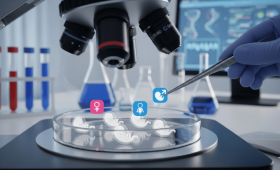In this article, we offer a comprehensive, evidence-based guide to maternal nutrition, a critical factor affecting the lifelong health of both the pregnant woman and her baby. Our content challenges the common “eating for two” mentality and instead adopts a nuanced, trimester-specific approach to calorie intake that prioritizes nutrient density over quantity. We detail the essential roles of essential macronutrients and micronutrients, such as protein, iron, folic acid, calcium, and omega-3 fatty acids, and provide nutritional recommendations for you by explaining their physiological importance for fetal development and maternal health.
A significant portion of our content focuses on the importance of food safety, providing a detailed breakdown of specific foods and substances to avoid. The rationale behind these recommendations is based on the science of reducing the risks from foodborne illnesses such as Listeria and Toxoplasma gondii, as well as toxins like mercury. Our content offers practical, food-based strategies for managing common pregnancy discomforts and provides personalized nutritional guidance for special diets, such as vegetarian or vegan.
Our content goes beyond immediate health issues to examine the long-term, intergenerational effects of maternal nutrition, a concept known as fetal programming. Evidence suggests that a pregnant person’s diet can permanently alter a child’s growth, structure, and metabolism, affecting their risk of developing chronic diseases such as obesity, diabetes, and even some neurodevelopmental disorders. Our content concludes by emphasizing that healthy eating during pregnancy is a critical investment for the lifelong well-being of both mother and child, and that this commitment is most effective when initiated before conception.
The Core Principles of a Healthy Pregnancy Diet
The journey of pregnancy represents a period of profound physiological transformation, demanding a foundational shift in nutritional priorities. Rather than a “special diet” or the misconception of “eating for two,” the guiding principle for maternal nutrition is a balanced approach that emphasizes adequacy, variety, and the strategic timing of nutrient intake. The primary objective is to provide a rich array of nutrients to support the intricate processes of fetal development and maintain the pregnant person’s health, rather than simply consuming more calories. This approach reframes the task from a restrictive diet plan to a mindful, intentional continuation of a healthy lifestyle.
Caloric Needs by Trimester: A Shifting Energy Landscape
The energy requirements of pregnancy are not static; they evolve in a trimester-by-trimester progression, reflecting the dynamic growth trajectory of the developing fetus.
- First Trimester (Weeks 1-12): During the initial phase of pregnancy, no additional calories are typically needed. The focus should be on nutrient-dense foods to support foundational development and manage common symptoms like nausea.
- Second Trimester (Weeks 13-26): As the baby’s growth accelerates, the body requires an additional 300 to 340 extra calories per day. These additional calories fuel fetal development, the growth of the placenta, and the increase in maternal blood volume.
- Third Trimester (Week 27 to Delivery): The need for energy peaks in the final trimester to support the baby’s most rapid period of growth. An additional 400 to 450 calories per day are generally recommended during this time.
While these numbers provide a general framework, it is important to recognize that they are guidelines, not rigid targets. Individual metabolic needs vary based on factors such as pre-pregnancy weight, physical activity level, and whether a multiple pregnancy is involved. Monitoring appropriate weight gain throughout pregnancy is a key indicator of a healthy diet and is associated with positive long-term health outcomes for both the pregnant person and the child.
Macronutrients Demystified: The Role of Carbohydrates, Proteins, and Fats
The core principles of macronutrient distribution—the proportion of carbohydrates, proteins, and fats in the diet—remain largely consistent with those for non-pregnant adults. However, as the body’s total energy needs increase, the absolute quantity of each macronutrient must also rise to meet the demands of fetal development.
- Carbohydrates (45-65% of daily calories): As the primary source of energy for both the pregnant person and the fetus, carbohydrates are vital. The recommended daily allowance (RDA) increases from 130 grams to 175 grams per day to provide adequate glucose for the mother’s and the baby’s brain. A focus on complex, high-fiber, and whole-grain sources is recommended to provide sustained energy and support healthy digestion, which can help prevent constipation. Examples include brown rice, whole-wheat pasta, and oats.
- Protein (10-35% of daily calories): Protein is a fundamental building block for the fetus’s muscle and tissues, as well as for the mother’s increased blood volume and the production of hormones and antibodies. The RDA for protein increases to a minimum of 60 grams per day, often averaging 71 grams per day for an average woman, which is approximately 25 grams more than the non-pregnant requirement.
- Fats (20-35% of daily calories): Fats are crucial for energy provision, the absorption of fat-soluble vitamins, and the development of the fetal brain. The emphasis should be on healthier unsaturated fats, such as those found in avocados, nuts, and vegetable oils, while limiting saturated fats to less than 10% of total caloric intake.
This approach, which maintains the proportional balance of the diet while increasing the total volume of food, provides a sophisticated framework for understanding and implementing a healthy pregnancy diet.
Table 1: Daily Caloric and Macronutrient Requirements by Trimester
| Trimester | Additional Daily Calories | Key Macronutrient RDA (g/day) | Key Nutritional Focus |
| First (Weeks 1-12) | 0 | Protein: 52 g/day; Carbohydrates: 175 g/day | Nutrient density, managing nausea, and establishing a healthy eating pattern. |
| Second (Weeks 13-26) | 300-340 | Protein: 71 g/day; Carbohydrates: 175 g/day | Supporting rapid fetal growth with increased energy and protein intake. |
| Third (Week 27-Delivery) | 400-450 | Protein: 71 g/day; Carbohydrates: 175 g/day | Meeting peak energy demands for final fetal growth and preparing for labor. |
Essential Micronutrients for Fetal and Maternal Health
While a balanced diet of macronutrients provides the energy and building blocks for a healthy pregnancy, specific micronutrients are indispensable for preventing birth defects, supporting fetal development, and maintaining maternal health.
Folic Acid: The Non-Negotiable Nutrient for Neural Development
Folic acid, a B vitamin, is arguably the single most critical nutrient in early pregnancy. Its primary function is to support DNA synthesis, cell division, and, most importantly, the development and closure of the neural tube, which forms the baby’s brain and spinal cord. An adequate intake of folic acid significantly reduces the risk of severe birth defects such as spina bifida and anencephaly. Furthermore, its benefits extend to a lower risk of premature birth, low birth weight, and cleft lip and palate.
The physiological timeline of this development is crucial. The neural tube forms and closes within the first month of pregnancy, often before a person is even aware they are pregnant. This reality makes pre-conception supplementation an imperative. Guidelines recommend an intake of 400 micrograms (mcg) per day before conception, increasing to 600 mcg per day during pregnancy. While folate is found in foods like dark leafy greens, citrus fruits, and dried beans, fortified foods and a daily supplement are often necessary to guarantee the required intake.
Iron: Fueling Oxygen Delivery and Preventing Anemia
Iron is essential for the production of hemoglobin, the protein in red blood cells that carries oxygen. During pregnancy, the body’s blood volume can increase by up to 50%, nearly doubling the need for iron to supply oxygen to both the pregnant person’s tissues and the developing fetus. Iron is also vital for the baby’s brain development. A deficiency can lead to maternal anemia, causing extreme fatigue, and can increase the risk of premature birth and low birth weight. The recommended daily intake is 27 milligrams (mg).
While iron is available in lean red meat, poultry, and fish, it is also found in plant-based sources like fortified cereals, beans, and leafy green vegetables. However, the body absorbs iron from animal sources (heme iron) more efficiently than from plant sources (non-heme iron). A practical strategy to enhance the absorption of non-heme iron is to pair iron-rich foods with foods high in vitamin C, such as orange juice or strawberries. Conversely, calcium can inhibit iron absorption, so it is recommended to avoid consuming calcium-fortified orange juice with iron supplements.
Calcium & Vitamin D: Building a Strong Skeleton
Calcium and Vitamin D are intrinsically linked in their function of building and maintaining a strong skeleton for both the mother and the baby.
- Calcium: The baby requires calcium to develop bones and teeth. Adequate intake is also linked to a reduced risk of preeclampsia, a serious condition characterized by a sudden increase in blood pressure. Pregnant adults need 1,000 mg of calcium daily, while pregnant teenagers require 1,300 mg. Excellent sources include dairy products, fortified plant-based milks, and fish with edible bones.
- Vitamin D: This vitamin regulates the body’s calcium and phosphate levels, which are essential for healthy bones, teeth, and muscles. A deficiency is associated with a higher risk of gestational diabetes, preeclampsia, and preterm birth. The recommended daily intake is 600 International Units (IU). Sources include sunlight exposure, fortified foods, and fatty fish.

Omega-3 Fatty Acids: Nourishing the Fetal Brain and Eyes
Omega-3 fatty acids, particularly DHA and EPA, are crucial for the baby’s brain and eye development, with a significant portion of this accumulation occurring in the final trimester. Sources include oily fish like salmon and sardines, as well as plant-based options such as walnuts, flaxseed, chia seeds, and algae oil.
The Supporting Cast: Choline, Iodine, and Zinc
Several other micronutrients, while needed in smaller quantities, play equally vital roles in fetal development and maternal health. Choline is important for brain development, while iodine is essential for hormone balance and cell function. Zinc is a component of many enzymes and is involved in protein synthesis and immune function. These nutrients are found in foods such as eggs, lean meats, seafood, iodized salt, and whole grains.
Key Nutrients for Pregnancy
| Nutrient | Recommended Daily Intake | Primary Function | Good Food Sources |
| Folic Acid (Folate) | 400 mcg before pregnancy; 600 mcg during pregnancy | Prevents neural tube defects; supports DNA synthesis | Fortified cereals/breads, dark leafy greens, citrus fruits, lentils, beans |
| Iron | 27 mg/day | Prevents maternal anemia; supports fetal brain development and oxygen delivery | Lean red meat, poultry, fish, fortified cereals, beans, spinach |
| Calcium | 1,000 mg/day (adults); 1,300 mg/day (teenagers) | Builds fetal bones and teeth; supports nerves, muscles, and blood vessels | Dairy, fortified plant milks, fish with bones, broccoli, kale |
| Vitamin D | 600 IU/day | Aids calcium absorption; supports bone/teeth development | Sunlight, fatty fish (salmon), fortified milk and juices, eggs |
| Omega-3 Fatty Acids | Varies; DHA supplement of 200-300 mg/day for vegans | Critical for fetal brain and eye development | Oily fish (salmon, sardines), walnuts, flaxseed, chia seeds, algae oil |
| Choline | Varies; supplements may be needed | Important for fetal brain development | Eggs, lean meats, seafood, beans, and lentils |
| Iodine | Varies; supplements may be needed | Important for baby’s brain development and hormone balance | Iodized salt, dairy products, eggs, seaweed |
| Zinc | Varies; intake may be insufficient | Involved in cell growth, protein synthesis, and immune function | Leavened whole grains, legumes, soy foods, milk, and yogurt |
Navigating Food Safety: What to Avoid and Why
During pregnancy, a person’s immune system is naturally suppressed, making them and their unborn child more susceptible to foodborne illnesses. These infections can be more severe and have devastating consequences for the fetus, including miscarriage, stillbirth, or premature delivery, even if the mother experiences only mild, flu-like symptoms. A detailed understanding of what to avoid and the rationale behind these restrictions is therefore a cornerstone of a healthy pregnancy diet.
The Risk of Foodborne Illnesses: Listeria, Salmonella, and Toxoplasmosis
- Listeria : This bacteria can cause listeriosis, a serious infection. It is found in unpasteurized dairy products, soft cheeses, refrigerated deli meats, hot dogs, and cold cooked chicken. Interestingly, it has also been linked to outbreaks from seemingly healthy foods like bagged salads and enoki mushrooms.
- Toxoplasmosis : This parasitic infection is a risk from eating raw or undercooked meat, cured meats, and unwashed fruits and vegetables that have been in contact with contaminated soil.
- Salmonella : A common cause of food poisoning, this bacteria is often found in raw or undercooked eggs and meat.
Risky Foods: A Detailed Breakdown
The dangers associated with many high-risk foods are not inherent to the foods themselves but arise from the potential presence of harmful bacteria or toxins. Proper preparation can often mitigate these risks.
- Uncooked Meats and Seafood: All raw or rare meat, poultry, and seafood (sushi, sashimi, raw oysters) must be avoided due to the risk of parasites and bacteria. For deli meats and hot dogs, a simple and effective rule is to reheat them to “steaming hot” (165°F or 74°C) to kill any potential Listeria.
- Soft Cheeses: Mould-ripened soft cheeses (e.g., Brie, Camembert) and soft blue cheeses (e.g., Roquefort, Gorgonzola) should be avoided unless they are cooked until steaming hot. Hard cheeses, processed cheese, cream cheese, and cottage cheese, when made with pasteurized milk, are generally considered safe.
- Raw Eggs: Unless eggs are from a certified program (e.g., British Lion Code of Practice), they should be cooked until the white and yolk are hard to eliminate the risk of Salmonella. Foods containing raw eggs, such as homemade mayonnaise, mousse, and cake batter, should also be avoided.
- Unpasteurized Products: Raw milk, juice, and cider should be avoided as they have not been processed to kill harmful bacteria.
- Liver and High-Dose Vitamin A: Liver and liver products contain very high levels of Vitamin A, which, in excess, can be harmful to a developing fetus and potentially cause birth defects. High-dose Vitamin A supplements should also be avoided.
Table 3: Foods to Avoid or Limit and Their Associated Risks
| Food/Substance Category | What to Avoid/Limit | Why? |
| Meat & Poultry | Raw or undercooked meat (rare steak), cured meats (salami), cold cooked chicken, deli meats, hot dogs | Risk of Toxoplasma gondii, Listeria, and Salmonella |
| Seafood | Raw or undercooked seafood (sushi, sashimi, oysters), cold-smoked/cured fish, refrigerated pre-made seafood salads | Risk of Listeria, parasites, viruses, and toxins |
| High-Mercury Fish | Shark, swordfish, marlin, king mackerel, orange roughy | High mercury content can harm the baby’s nervous system |
| Dairy & Eggs | Unpasteurized milk/juice/cider, soft cheeses (Brie, Camembert, Gorgonzola), soft-serve ice cream, raw or undercooked eggs (unless certified) | Risk of Listeria, Salmonella, and E. coli |
| Vegetables & Fruits | Unwashed produce, raw sprouts, pre-prepared salads from delis or salad bars | Can harbor soil-borne Toxoplasma gondii or other bacteria like Listeria and Salmonella |
| Misc. Foods | Raw dough/batter, refrigerated pâté/meat spreads | Can contain E. coli (from flour) or Listeria |
| Other Substances | Alcohol, caffeine (>200 mg/day), liquorice root, high-dose Vitamin A supplements | Alcohol can cause long-term harm; excess caffeine/Vitamin A can increase health risks |
Mercury in Fish: A Guide to Safe Seafood Consumption
While certain fish must be avoided, a blanket ban on seafood is not advisable. The evidence demonstrates that the benefits of consuming fish, particularly for the essential omega-3 fatty acids that support the baby’s brain and eye development, outweigh the risks when the correct types and quantities are consumed.
The primary concern is methylmercury, a neurotoxin that accumulates in larger, predatory fish. This toxin can pass through the placenta and is particularly harmful to the developing fetal nervous system. Therefore, a nuanced approach is required, balancing the benefits of omega-3s against the risk of mercury exposure.
- Fish to Avoid: Species that contain the highest levels of mercury, such as shark, swordfish, marlin, orange roughy, and king mackerel, should be avoided entirely.
- Fish to Limit: Due to potential pollutants, consumption of oily fish like salmon, trout, and mackerel should be limited to no more than two portions a week. Tuna, which contains more mercury than other commonly consumed fish, should also be limited to a maximum of two steaks or four medium-sized cans per week.
- Fish to Eat (Safe Choices): It is recommended to eat 8-12 ounces of a variety of low-mercury fish each week, such as cod, salmon, shrimp, and canned light tuna, to gain the benefits of their nutrients without undue risk.
This approach of risk mitigation based on species, rather than a total ban on all seafood, allows the pregnant person to reap the benefits of crucial nutrients while minimizing exposure to toxins.
Substance Limits: Caffeine, Alcohol, and Other Substances
Beyond food, certain substances require careful moderation or complete avoidance.
- Alcohol: The safest and most widely recommended approach is to abstain from alcohol entirely during pregnancy, as it has been shown to cause long-term harm to a baby’s growth and development.
- Caffeine: The daily intake of caffeine should be limited to no more than 200 mg to reduce the risk of pregnancy complications such as low birth weight and miscarriage. Common sources include coffee (a mug of instant has ~100 mg, filter coffee has ~140 mg) and certain teas.
- Herbal Teas: The caffeine and herbal content of these teas can vary significantly, with some herbs being potentially dangerous in high quantities, particularly in the first trimester. It is recommended to check the ingredients and limit consumption to one to two cups per day.

Practical Strategies for Common Pregnancy Discomforts
Pregnancy is often accompanied by physiological discomforts that can make maintaining a healthy diet challenging. Fortunately, many of these issues can be managed with simple, food-based strategies.
Morning Sickness: Dietary Tactics for Combating Nausea
Nausea and vomiting, commonly known as morning sickness, can be exacerbated by an empty stomach, greasy foods, and strong smells. The key is to manage blood sugar levels and avoid foods that are difficult to digest.
- Eat Small, Frequent Meals: Consuming small meals every one to two hours can prevent an empty stomach from triggering nausea.
- Choose Bland, Low-Fat Foods: Opt for easy-to-digest, carbohydrate-rich foods like crackers, toast, rice, bananas, and applesauce. These can be particularly helpful in the morning before getting out of bed.
- Sip Fluids Separately: Drinking liquids about 20-30 minutes before or after meals, rather than with them, can reduce feelings of fullness and nausea.
- Consider Ginger: Foods and drinks containing ginger, such as ginger tea or ginger lollipops, may help alleviate nausea for some individuals.
This approach of choosing simple, low-fat foods and eating frequently may seem to conflict with cravings for high-fat or sugary foods. However, prioritizing the management of nausea through these dietary choices often leads to greater comfort and improved overall dietary adherence.
Heartburn and Constipation: Food-Based Remedies
- Heartburn: This discomfort is caused by pressure on the stomach and can be managed by eating smaller, more frequent meals. Avoiding highly seasoned, rich, and fatty foods is also recommended. It is important to avoid lying down flat immediately after eating and instead elevate the head and shoulders with pillows if rest is necessary.
- Constipation: A common side effect of hormonal changes and iron supplements, constipation can be relieved by increasing the intake of fiber and fluids. Consuming high-fiber foods such as whole grains, fruits, raw vegetables, and dried fruits like prunes or figs can soften stool and promote bowel activity. Staying well-hydrated and engaging in regular physical activity, such as walking, also helps alleviate symptoms.
Managing Cravings and Aversions
Cravings and aversions are a common and often powerful aspect of pregnancy. While aversions to foods that pose a high risk of foodborne illness may be an evolutionary protective mechanism, cravings often lean toward less nutritious options.
- Strategies for Management: Maintaining a regular meal schedule can help stabilize blood sugar and prevent intense cravings. Staying well-hydrated can also help, as thirst is often mistaken for hunger. Preparing healthy snacks in advance, practicing healthy food swaps (e.g., fruit for sweets), and avoiding grocery shopping on an empty stomach are practical, proactive measures. Finally, it is important not to completely deprive oneself; allowing for small indulgences can prevent a later food binge. This balanced approach, combining proactive planning with mindful indulgence, provides a sustainable way to navigate the psychological and physiological aspects of pregnancy nutrition.
Tailoring Your Diet: Considerations for Specific Lifestyles
While the foundational principles of a healthy pregnancy diet apply universally, certain lifestyles, particularly vegetarian and vegan ones, require careful attention to specific nutrients to ensure complete and adequate intake.
The Vegetarian and Vegan Pregnancy: Ensuring Complete Nutrition
A well-planned vegetarian or vegan diet can provide all the necessary nutrients for a healthy pregnancy, but it is essential to monitor the intake of nutrients that are predominantly found in animal products.
- Protein: Vegans need to consume a variety of plant-based protein sources, such as legumes, tofu, nuts, seeds, and whole grains, to ensure they acquire a complete profile of essential amino acids.
- Vitamin B12: This vitamin is found almost exclusively in animal products. Vegans must rely on fortified foods (e.g., nutritional yeast, fortified cereals, and plant-based milks) or supplements to meet their needs.
- Iron: The body’s absorption of plant-based iron is less efficient. Therefore, it is crucial for vegetarians and vegans to intentionally pair iron-rich plant foods with sources of vitamin C to enhance absorption.
- Other Key Nutrients: A vegetarian or vegan diet also necessitates a mindful approach to acquiring sufficient calcium, vitamin D, iodine, and zinc. Fortified plant-based milks, dark leafy greens, and iodized salt are key dietary components.
Table 4: Vegan Food Sources for Essential Nutrients
| Nutrient | Plant-Based Food Source Examples | Notes |
| Protein | Legumes, tofu, tempeh, seitan, nuts, seeds, whole grains | Consume a variety of sources daily for a complete amino acid profile |
| Vitamin B12 | Fortified nutritional yeast, fortified cereals, fortified plant-based milk | Supplementation is strongly recommended due to limited natural sources |
| Iron | Fortified cereals, dried fruit, leafy greens, beans, lentils, nuts, seeds, tofu | Pair with foods high in Vitamin C to maximize absorption |
| Calcium | Fortified plant milks, low-oxalate leafy greens, sesame seeds, almonds, calcium-set tofu | Check labels for fortification; choose low-fat options |
| Omega-3s | Flaxseed, walnuts, hempseed, chia seeds, algae oil | Algae oil is a direct source of DHA; other sources provide ALA, which the body converts less efficiently |
| Iodine | Iodized salt, seaweed, nori | Levels in plant foods depend on soil; iodized salt is a reliable source |
| Zinc | Legumes, soy foods, pumpkin seeds, cashews, fortified cereals, whole grains | Zinc from plant foods is less absorbed; ensure consistent intake |
The Importance of Supplements: When Diet Isn’t Enough
While a healthy, varied diet is the ideal way to obtain nutrients, supplements serve as a crucial safeguard to fill potential nutritional gaps. Supplements are not a replacement for a healthy diet but rather a critical tool to ensure that both the mother and baby receive all necessary nutrients, even on days when dietary intake falls short.
- Folic Acid: A daily supplement is recommended for all women of childbearing age, as the neural tube develops so early in pregnancy that waiting for a positive pregnancy test is often too late to fully mitigate the risk of neural tube defects.
- Vitamin D: A daily supplement is often recommended, especially for individuals with limited sun exposure or those who cover their skin when outdoors.
- Other Supplements: Iron is frequently recommended due to the body’s significantly increased needs, and an omega-3 fatty acid supplement may be advised for those who do not regularly consume fish.
A key consideration is dosage. High doses of certain vitamins, particularly Vitamin A, can be harmful to a developing fetus. It is therefore essential to consult with a healthcare provider for personalized supplement recommendations to ensure the correct amounts are taken and potential risks are avoided.
Long-Term Impacts: Programming Health for a Lifetime
Maternal nutrition during pregnancy is not merely about supporting immediate growth; it is about “programming” the child’s long-term health, a concept supported by the “Developmental Origins of Health and Disease” (DOHaD) hypothesis. The dietary environment in the womb can permanently alter a baby’s metabolism, structure, and future susceptibility to chronic diseases.
Fetal Programming: The Link Between Prenatal Nutrition and Chronic Disease
The evidence indicates a delicate “Goldilocks Zone” for maternal nutrition, where both under- and over-nutrition can have profound and lasting effects.
- Impact of Undernutrition: Fetal undernutrition, even for a short period, is associated with a higher risk of chronic diseases in adulthood, including obesity, type 2 diabetes, and cardiovascular disease. This is exemplified by the follow-up of individuals exposed to the Dutch Famine of 1944-45 in utero, which showed an increased risk of obesity in adulthood. The biological rationale is that the fetal body, adapting to a state of scarcity, programs itself for efficient fat storage and a thrifty metabolism, which can become a disadvantage when exposed to a modern, calorie-rich diet later in life.
- Impact of Over-nutrition: Conversely, an unhealthy diet or excessive weight gain during pregnancy can also increase a child’s risk of later-life obesity and cardiometabolic disorders. This highlights that a “more is better” approach to eating during pregnancy is fundamentally flawed.
- Micronutrient Nuance: This delicate balance extends to micronutrients as well. Studies have shown that both maternal iron deficiency and iron excess during pregnancy can be linked to adverse cognitive outcomes in children. Similarly, while folate is critical for neural development, over-supplementation has been suggested to potentially increase the risk of neurodevelopmental disorders such as autism spectrum disorder (ASD) in children. This reinforces the importance of professional medical guidance in determining appropriate nutrient levels.
Maternal Health Beyond Pregnancy: Nutrition for Postpartum and Lifelong Well-being
The benefits of a healthy pregnancy diet extend well beyond delivery, significantly impacting the mother’s long-term health. A balanced diet can reduce the risk of gestational diabetes and hypertension, which can, in turn, lower the mother’s risk of developing type 2 diabetes and high blood pressure later in life. Furthermore, proper nutrition supports the mother’s postpartum recovery, helps her replenish nutrient stores, and provides the necessary energy and nutrients for lactation.
A Blueprint for a Healthy Pregnancy
The act of feeding during pregnancy is a critical investment in the lifelong health of both mother and child. This report establishes that a healthy pregnancy diet is not a rigid or esoteric regimen but an intentional, balanced, and nuanced approach to nutrition. It debunks the myth of “eating for two,” replacing it with a trimester-specific understanding of caloric and macronutrient needs. It provides a detailed, evidence-based guide to essential nutrients, emphasizing that some, like folic acid, are so vital that supplementation is a non-negotiable safeguard even before conception.
The importance of food safety cannot be overstated. By understanding the rationale behind avoiding certain foods, particularly the risks associated with Listeria and mercury, the pregnant person is empowered to make informed choices that mitigate risk without unnecessary dietary restriction. Finally, by adopting a comprehensive and mindful nutritional strategy, a pregnant person is not only nurturing a healthy pregnancy but is also actively programming a healthier future for their child and investing in their own long-term well-being. This blueprint for a healthy pregnancy, grounded in a holistic understanding of nutritional science, is a powerful tool for a positive and healthy journey.



